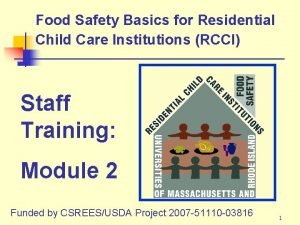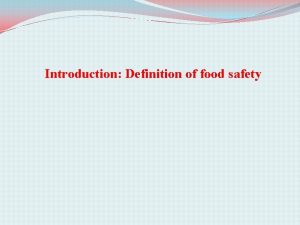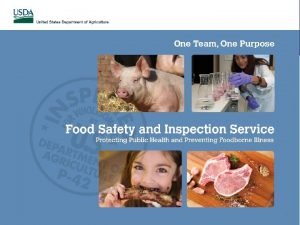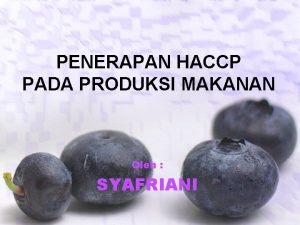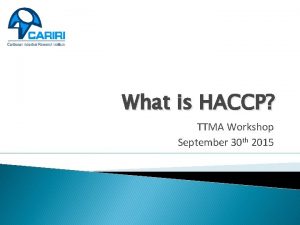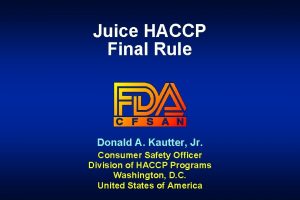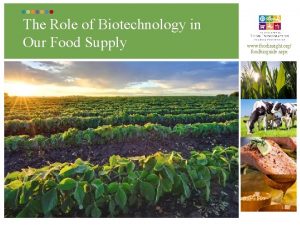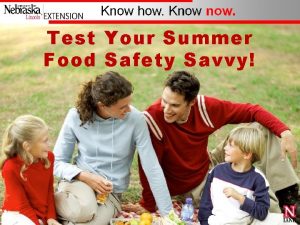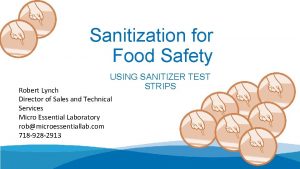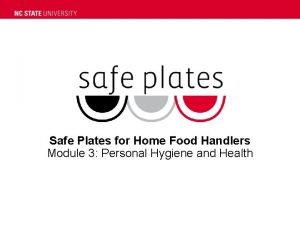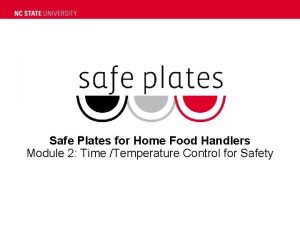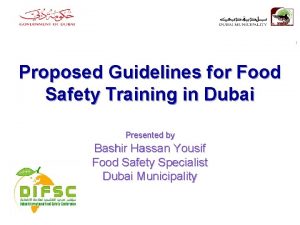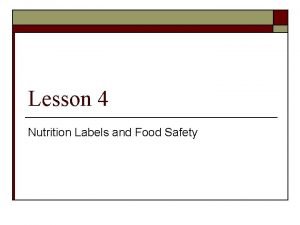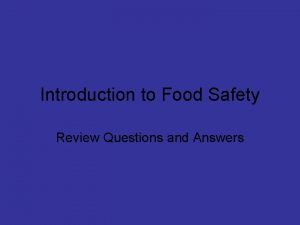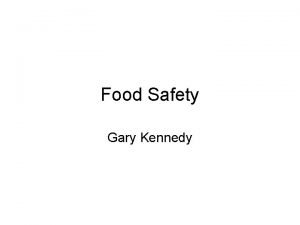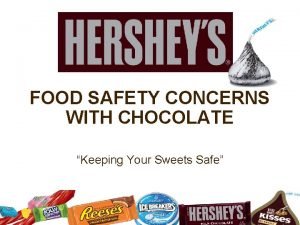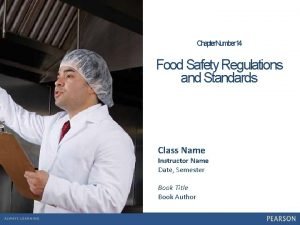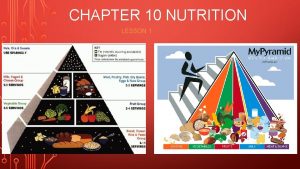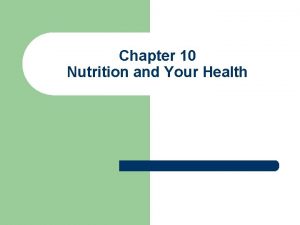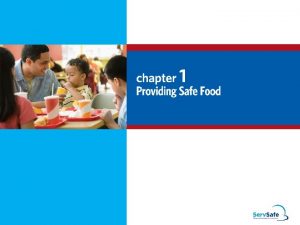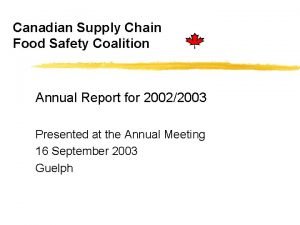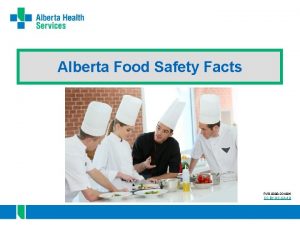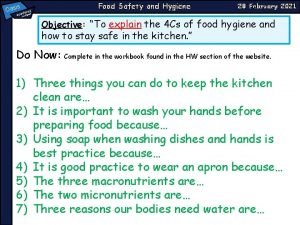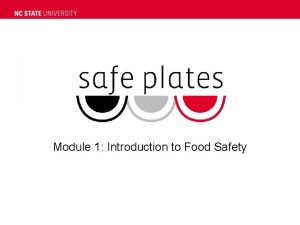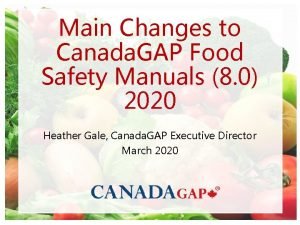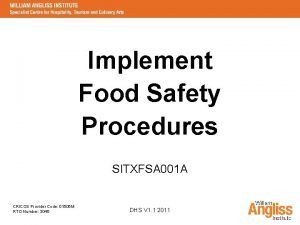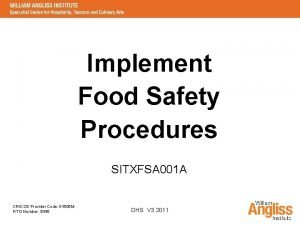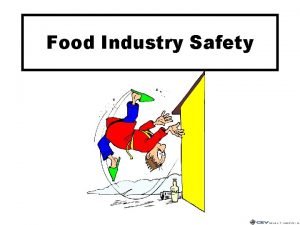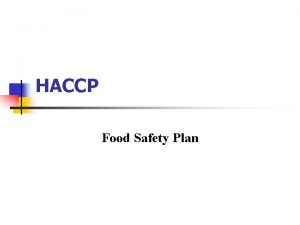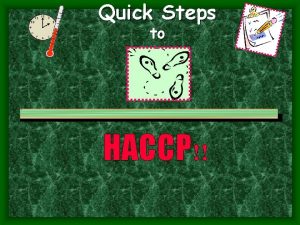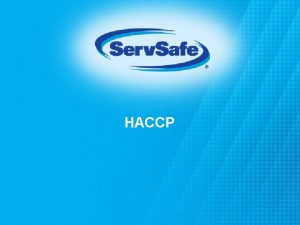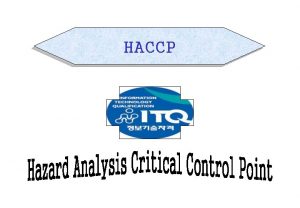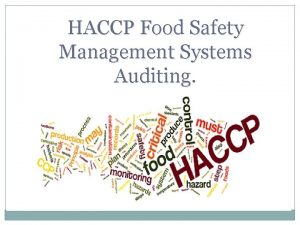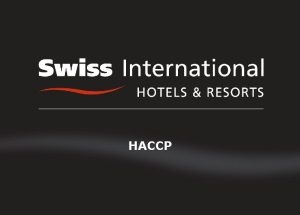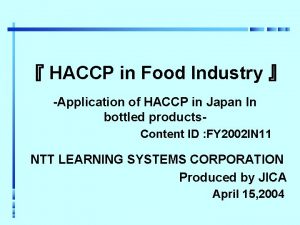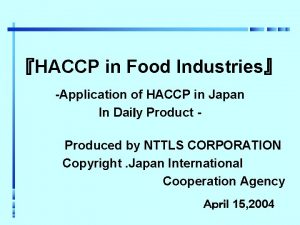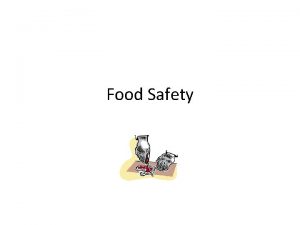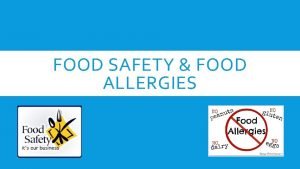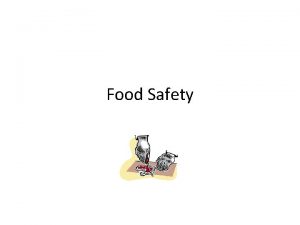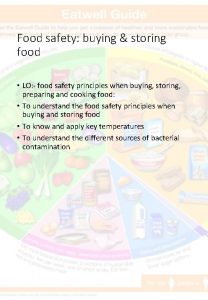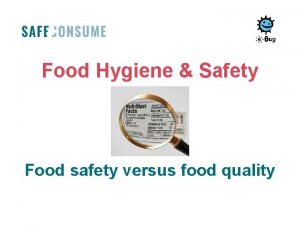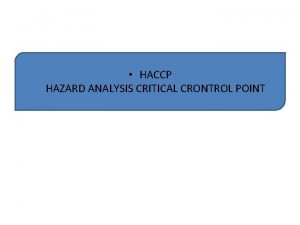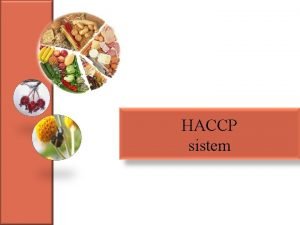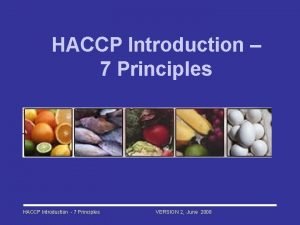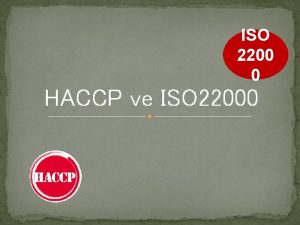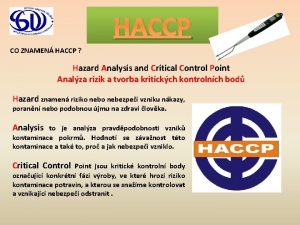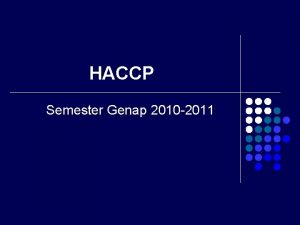HACCP Food Safety Plan Definition of HACCP A






































- Slides: 38

HACCP Food Safety Plan

Definition of HACCP • A systematic approach to construct a food safety program designed to reduce the risk of foodborne hazards by focusing on each step of the food preparation process –from receiving to service.

Controlling Hazards → Safe Food 1) Hazards involving food preparation, i. e. , improper cooking of beef, chicken, eggs, etc. 2) Hazards that affect all foods, such as poor personal hygiene.

Controlling Food Preparation Hazards 1. Identify Critical Control Points (CCPs) – Cooking, cooling, hot/cold holding, reheating 2. Control/prevention – Time and temperature

Controlling All Other Hazards • Develop and Implement Standard Operating Procedures (SOPs). – All activities except food preparation • Receiving, cleaning and sanitizing equipment and utensils, food storage, etc.

Step 1: Develop and Implement SOPs • Step–by-step written instructions for food service tasks that affect food safety

Sample SOPs • • • Cooking Potentially Hazardous Foods (PHF) Cooling PHF Holding Hot and Cold PHF Date Marking, Ready-to-eat (RTE), PHF Personal Hygiene Reheating PHF Receiving Deliveries Storing and Using Poisonous or Toxic Chemicals Using Suitable Utensils When Handling RTE Foods Washing Fresh Fruits and Vegetables Handwashing

SOPs for your use: • USDA is developing SOPs, the final versions posted at: www. nfsmi. org • Iowa State University’s “Safe Food” resources www. schoolhaccp. org/

Step 2: Classify all Menu Items using the “Process Approach ” • Categorizes food preparation into three broad categories based on how many times each menu item moves through the temperature danger zone (between 41°F and 135°F).

The Division of Foods is Based on Complete Trips through the Temperature Danger Zone 140 o. F 2 0 1 1 3 41 o. F No Cook Process 1 Same Day Process 2 Complex Process 3

Step 2 Classify all menu items • The “Process Approach” categories: – Process #1 – No Cook – Process #2 – Same Day Service – Process #3 – Complex Food Preparation

Process #1 – No Cook • The menu item does not go completely through the danger zone in either direction. • Examples: fresh fruit and vegetables, salad bar items.

Process #2 – Same Day Service • The menu item takes one complete trip through the danger zone (going up during cooking) and is served. Or • Anything that is cooked and served in the same day

Process #3 Complex Food Preparation • The menu item goes through both heating and cooling, taking two or more complete trips through the danger zone. • These items are cooked, cooled and reheated.

Step 3 – Identify and document control measures and critical limits • Control measures prevent, eliminate, or reduce hazards. – Control measures include SOPs as well as the CCPs (cooking, cooling, reheating, holding) and the critical limits (times and temperatures) established in each of the three “processes”.

Example - Chicken • Process 1 – We purchase pre-prepared chicken salad and hold it cold to be served on the salad bar or on sandwiches. • Process 2 – We cook frozen or fresh chicken and serve it the same day. • Process 3 – We cook frozen or fresh chicken, cool it and use it to make chicken salad from scratch or – We cook frozen or fresh chicken, serve it the same day, have leftovers, cool it down and on another day we heat it up and serve it.

Let’s Practice! • Garden Salad • Grilled Ham & Cheese • Leftovers • Garlic Breadsticks • Sub Sandwich • Peach Cobbler • Spaghetti • Pasta Salad • • • Hot Pocket Salsa Tortilla Chips Burrito (pre-prepared) Hamburger Sliced Tomato & Lettuce • Canned Pears • Chili

CCP for Process #1 – No Cook • Cold holding or limiting time in the danger zone to inhibit bacterial growth and toxin production. (Food that is held at room temperature for four hours must be discarded. )

CCPs for Process #2 – Same Day Service • Cooking to destroy harmful bacteria and other pathogens. • Hot holding or limiting time in the danger zone to prevent the outgrowth of sporeforming bacteria.

CCPs for Process #3 – Complex Food Preparation • Cooking to destroy harmful bacteria & other pathogens. • Cooling to prevent the outgrowth of spore-forming bacteria. • Hot and cold holding or limiting time in the danger zone. • Reheating for hot holding.

CCPs and their Critical Limits • Each CCP (cooking, cooling, reheating, holding) must include time and/or temperature limits. For example, when cooking chicken, the time/temperature limit is 165°F for 15 seconds.

Calibrating a Bi-Metallic Stemmed Thermometer Calibration Nut-----> Dimple-----> Ice Water Bath -----> When to Calibrate: • Daily • After extreme temperatures • After bumping or dropping How to Calibrate: • Insert stem in ice water bath (without touching bottom or sides) • Adjust nut until needle indicates 32 o. F (freezing point)

Cooling Requirement Two-stage Method (6 Hours) (i. e. , products cooked day before) £ 70 o. F within 2 hours £ 41 o. F within 4 more hours • Take temperatures at 2 and 6 hour intervals to make sure that temperatures were reached. • Reheat above 165 o. F if food has not cooled to 70 o. F in 2 hours or 41 o. F in 6 hours. • Discard if more than 70 o. F after 2 hours or more than 41 o. F after 6 hours. One-stage Method (4 Hours) (i. e. , leftovers) £ 41 o. F within 4 hours • Take temperature after 4 hours to make sure that temperature was reached. • Reheat above 165 o. F if food has not cooled to 41 o. F in 4 hours.

Documentation • You must document CCPs (heating, cooling, hot/cold holding, reheating) and Critical Limits (temperatures/times) for each menu item you sorted into the three “processes”. • HOW? Recipes and SOPs

Where to Record Process Number • Write the process number on each recipe • Make a poster for each process and list the foods that belong in each Process 1 – No Cook ALL RECEIVE STORE Process 2 – Same Day • Write the process number on the menu PREPARE COLD HOLD SERVE Tossed Salad Gelatin with Peaches

Recipes • Should include final and holding temperatures. – USDA Quantity Recipes for School Food Service www. nfsmi. org/Information/school_recipe_ alpha. htm.

Bridging the Gaps • SOPs for menu items that do not have recipes, cooling foods and reheating leftovers.

Step 4: Monitoring • Control measures (i. e. , cooking times & temperatures) must be monitored and documented in writing. – How? – When and how often? – Who is responsible for monitoring?

Monitoring Example • Cold foods must be kept at 41°F or below. – The temperature of the refrigerator must be recorded on a refrigeration temperature monitoring chart at least two times daily to make sure the temperature is 41°F or below.

Step 5: Corrective Actions • Must be carried out immediately whenever a critical limit is not met. – Examples: • Continue to heat to required temperature • Rejecting food delivery • Discarding food held too long without temperature control

Corrective Action Examples The temperature in the refrigerator is above 41°F SOP – The equipment must be checked. The thermometer used to record the temperature should be calibrated regularly and checked to see if it is working properly. – Any PHF should be temped. If unable to determine if the food has been in the danger zone for less than 4 hours, discard.

Corrective Action Example The freezer temperature is 49°F when you arrive to work on Monday morning SOP – Take temperature of food in freezer – Any food above 41°F must be discarded – Any foods below 41°F shall be transferred to a refrigerator immediately and used within 2 -3 days (never re-freeze)

Step 6 – Keep Records • Food Safety Plan & Training • Monitoring Temperatures of food, equipment & food storage areas and equipment • Calibration Records • Corrective Action

Examples of Required Documentation • • SOPs Time and Temperature charts Corrective Action records (when applicable) Verification/Review records Calibration records Training logs Receiving logs

Step 7: Review & Revise Food Safety Program Periodically • Ongoing monitoring • Periodic – at least yearly – to reflect facility or equipment changes (i. e. , new equipment and menu items)

Factors Contributing to Your Success • • Facility Equipment Managers Employees

All Employees should have: • • Initial food safety training On-going food safety training Record of training kept by district Training standards monitored daily by manager • Review of SOP guidelines at least yearly

HACCP Program Requirements 1. A written plan at each site that includes: a) Documenting menu items in the appropriate “process” category. b) Documenting Critical Control Points of food production. c) Monitoring d) Establishing and documenting corrective action. e) Recordkeeping f) Reviewing and revising the overall food safety program periodically.
 What is food safety
What is food safety Unit 2 food food food
Unit 2 food food food Sequence of food chain
Sequence of food chain Residential child care institutions
Residential child care institutions Define food safety
Define food safety Incidental additives examples
Incidental additives examples Contoh haccp opor ayam
Contoh haccp opor ayam What is haccp plan
What is haccp plan Juice haccp plan
Juice haccp plan Four shades function for the encs
Four shades function for the encs Safety care 2 person stability hold
Safety care 2 person stability hold Personal safety vs process safety
Personal safety vs process safety Ind safety report
Ind safety report Basic safety construction site safety orientation
Basic safety construction site safety orientation Basic safety orientation
Basic safety orientation Biotechnology and food safety
Biotechnology and food safety Savvy food safety
Savvy food safety Test strips for food safety
Test strips for food safety Henss food safety stand for
Henss food safety stand for Tcs in food safety
Tcs in food safety Food safety management system template
Food safety management system template Food safety training in dubai
Food safety training in dubai Lesson 4 nutrition labels and food safety
Lesson 4 nutrition labels and food safety Module 1: introduction to food safety answers
Module 1: introduction to food safety answers Four steps to food safety
Four steps to food safety Gary kennedy food safety
Gary kennedy food safety Chocolate food safety
Chocolate food safety Food safety regulations and standards
Food safety regulations and standards Chapter 10 lesson 4 nutrition labels and food safety
Chapter 10 lesson 4 nutrition labels and food safety Chapter 10 lesson 4 nutrition labels and food safety
Chapter 10 lesson 4 nutrition labels and food safety Tcs foods
Tcs foods Canadian supply chain food safety coalition
Canadian supply chain food safety coalition Tcs food
Tcs food 4 c's of food safety
4 c's of food safety Module 1 introduction to food safety
Module 1 introduction to food safety Canada gap manual
Canada gap manual Sitxfsa001a
Sitxfsa001a Implement food safety procedures
Implement food safety procedures Food safety controls
Food safety controls



